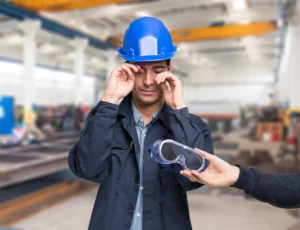In today’s industrial landscape, employee safety is more critical than ever. One of the most vulnerable areas for workplace injuries is the eyes, making an industrial safety eyewear program an essential part of any business’s overall safety strategy. Whether you’re in manufacturing, construction, or chemical processing, ensuring that employees have the right protective eyewear can prevent costly accidents and boost morale.
What is an Industrial Safety Program?
An industrial safety program is a structured set of guidelines and practices that aim to prevent workplace accidents, injuries, and fatalities. This involves the proper training of employees, safety audits, regular inspections, and the use of protective gear such as safety eyewear. The success of such programs depends on meticulous planning, execution, and ongoing management. It’s more than a legal requirement—it’s a moral obligation to keep workers safe.
Importance of Industrial Safety Eyewear Programs
The industrial safety eyewear program is a critical subset of an overall safety program. It specifically focuses on safeguarding the eyes of workers from various hazards like flying debris, chemical splashes, and radiation exposure. Many injuries can be prevented with proper eyewear, making this a focal point for companies serious about safety.
Industrial Prescription Safety Eyewear Program: A Necessity
For workers who already wear prescription glasses, the industrial prescription safety eyewear program ensures they get custom-fitted safety goggles that meet their vision correction needs while also offering protection. Not all safety eyewear can accommodate prescription lenses, so specialized programs help fill this gap.

Types of Industrial Eye Protection
Industrial eye protection comes in several forms:
- Safety Glasses: Standard eye protection for environments with low to moderate risk.
- Safety Goggles: Provide a tighter seal around the eyes, offering protection from liquids and fine particulates.
- Face Shields: Often used in conjunction with other eye protection, face shields offer broad protection from chemicals or sparks.
- Welding Helmets: Protect both the eyes and face from the harmful light and debris associated with welding.
Each type has its specific use cases, and the selection depends on the particular hazards present in the work environment.
Industrial Safety Goggles: A Closer Look
Industrial safety goggles offer superior protection compared to regular safety glasses. They fit tightly around the eyes, preventing dust, chemicals, and small particles from entering. They are indispensable in industries such as chemical processing, woodworking, and metalworking. Employees working in environments with liquid splashes, chemical exposure, or airborne particles are often required to wear these goggles.
Implementing an Industrial Safety Eyewear Program
A well-designed industrial safety eyewear program starts with a thorough risk assessment. Once the risks are identified, companies can choose the appropriate type of eyewear for each job. Regular training and eye protection maintenance should also be part of the program.
Steps to Implement:
- Risk Assessment: Identify the eye hazards in each area of the workplace.
- Choose the Right Eyewear: Depending on the risks, select from glasses, goggles, or face shields.
- Customization: For employees requiring prescription lenses, provide them with customized prescription safety eyewear.
- Training: Ensure employees understand when and how to wear their eyewear.
- Maintenance: Regularly inspect eyewear for damage and cleanliness.
- Program Review: Update and review the program regularly to ensure ongoing effectiveness.
Cost of Industrial Eyes Safety Eyewear Program
The cost of an industrial eyes safety eyewear program can vary depending on several factors. These include the number of employees, the specific types of protective eyewear needed, and whether prescription lenses are involved.
Typically, safety glasses cost between $10 to $50 per pair, while more specialized goggles or prescription eyewear can run between $100 and $300 per unit. While this may seem costly upfront, the investment pays off by reducing workplace injuries, avoiding lawsuits, and boosting employee confidence.
Benefits of Investing in an Industrial Safety Eyewear Program
Investing in an industrial safety eyewear program benefits companies in several ways:
- Reduced Injuries: Preventing eye injuries not only saves medical costs but also minimizes downtime.
- Compliance: Many industries have legal requirements for eye protection.
- Improved Employee Morale: Workers feel safer and more valued, leading to higher job satisfaction.
- Reduced Liability: A well-maintained safety program lowers the chances of lawsuits from work-related injuries.
FAQs
What is an industrial safety eyewear program?
An industrial safety eyewear program ensures that workers in hazardous environments are equipped with the appropriate eye protection to prevent injury.
How do I start an industrial prescription safety eyewear program?
To start, conduct a risk assessment to identify the necessary eyewear types, provide training for workers, and partner with suppliers that offer prescription safety eyewear.
What are the types of industrial eye protection?
The main types include safety glasses, safety goggles, face shields, and welding helmets, each designed to protect against specific workplace hazards.
How often should safety eyewear be replaced?
Safety eyewear should be inspected regularly for scratches, cracks, or other damage and replaced immediately if compromised.
How much does an industrial safety eyewear program cost?
The cost varies based on the type of eyewear and the number of employees but typically ranges from $10 to $300 per unit, depending on the customization needed.
Why are industrial safety goggles important?
Industrial safety goggles provide a higher level of protection by sealing around the eyes, preventing debris, chemicals, and dust from causing injuries.
Conclusion
An effective industrial safety eyewear program is vital for the well-being of employees and the success of any business operating in hazardous environments. Whether it’s basic safety glasses or custom prescription eyewear, providing the right protection can reduce workplace injuries, ensure compliance with regulations, and foster a culture of safety. The investment in such a program might seem significant, but the long-term benefits far outweigh the costs, making it an essential part of a company’s safety strategy.
